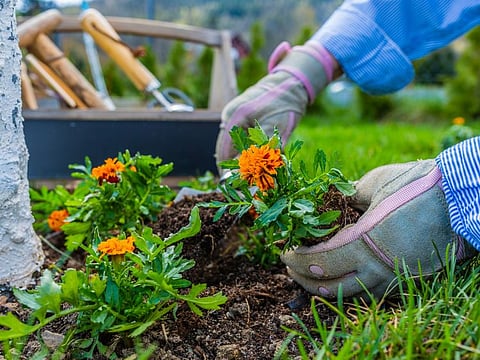Off the Cuff: Gardeners learn to see time differently
My understanding of the rhythms of a garden is a bittersweet blessing

I was at our local Home Depot this past weekend in search of a few basil plants to supplement the clump I had just stripped to make a large batch of pesto. That’s when I saw the display of hardy mums (more to the point, hearty meals for deer). And that is when I realized summer was as good as over. Everyone out of the pool.
We all have our unofficial ways of marking the passage of time. Often, they bear little resemblance to Pope Gregory XIII’s preferred method. Many, many semesters after certain people finish college, they continue to think in terms of the school calendar. As far as they’re concerned, the year starts in September and wraps up in June. For a couple of decades, I was similarly inclined. Now, as a hobbyist gardener, I’m governed by the vagaries of the planting season. My year begins in April and wraps at the end of August. I could stretch it out until right before the first frost by planting bulbs, but why prolong the goodbyes?
It all started with the acquisition of a weekend home in Connecticut (northeastern United States). Up to that point, as a big-city girl, I found that my interest in the great outdoors lay chiefly in its proximity to the great indoors. But inspired by a close friend with a green thumb and a crusading spirit, and by my husband’s cousin, a retired surgeon whose way with rhododendrons bordered on witchcraft, I tentatively began digging. Then I began digging in.
Let’s just say I had a lot to learn. I had no idea that it was possible to misplace - that is to say, bury - four pairs of Felco pruning shears over the course of a single month; that during one’s freshman year in the garden, the response to a deer sighting is “Bambi!” but by sophomore year it’s “venison!” As for the difference between partial sun and partial shade, well, I’m still kind of in the dark.
Black-eyed Susans
In the beginning, I also didn’t have a clue that flowering plants belong to discrete seasons - that, say, columbine and hellebore were mine for the taking at nurseries in April and May, but that I was essentially out of luck in late spring and early summer, when the offerings switched over to the likes of nepeta, hyssop and acanthus. And in midsummer, those plants would be mostly ousted by daylilies and coneflowers, still later by Rudbeckia hirta, also known as black-eyed Susans, and Russian sage.
Now, of course, I get it, but this new knowledge, my understanding of the rhythms of a garden, is a bittersweet blessing. I thrill - truly - to see the salvia, the dianthus and the phlox each year when they make it back for a return engagement. And I’ve heeded the advice of gardening experts who emphasise the importance, as they put it, of always having something interesting going on. In another words, as one mass of flowers closes up shop for the season, another should be all set to sprout - horticulture’s version of “when a door closes, a window opens.”
But I can’t put aside the fact that with each bud and bloom and fade cycle, first of the bleeding hearts, then the lilacs, then the irises, the Shasta daisies and the butterfly bush, it’s that much closer to fall.
I am trying, unfortunately with only limited success, to mature along with my plantings. They’ll come back, I keep reminding myself - the true definition of a perennial optimist.
— Washington Post
Joanne Kaufman is a visual artist and contemporary painter
Sign up for the Daily Briefing
Get the latest news and updates straight to your inbox



